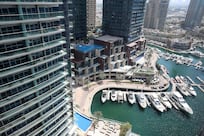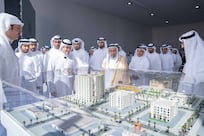When the gates at the Shanghai Expo shut for the final time today, the organisers will no doubt heave a huge sigh of relief.
A week ago the six-month expo reached its target figure of 70 million visitors, putting it well ahead of the previous record holder, the 1970 expo held appropriately by China's neighbour Japan. China has this year overtaken Japan as the world's number two economy.
The expo's completion spells the end of a frantic time for mainland China's business capital, with the wholesale redevelopment of a vast area of land, extra metro lines and a new airport terminal.
Estimates put the total cost at up to US$58 billion (Dh213.03bn).
There may have been some slightly dubious tactics employed to ensure enough people came - millions of free tickets and staff at government companies coerced into attending, according to reports - but the enthusiasm of visitors was undeniable. Some were prepared to queue for eight hours to enter the most popular pavilions.
Saudi Arabia's IMAX cinema pavilion was a hit, and the UAE's sand dune building, with its high-tech film shows, was also a big draw.
Queues stretched around the block for some pavilions, including those belonging to the UK, Japan, Australia, the US, Spain and South Korea.
"It was for China to showcase its achievements and show its capabilities to organise such a big event," says Frank Song, a professor in economics and finance at the University of Hong Kong.
But the event, Prof Song says, was about much more than demonstrating to outsiders the nation's capabilities to stage a world-class extravaganza. China had already done that spectacularly two years ago with the Olympics in Beijing.
He says the expo was also a way for the country's rulers, whose legitimacy depends on their continued delivery of economic growth, to drum up patriotic fervour and demonstrate what they could do for the populace. The overwhelming majority of visitors have been Chinese.
"The government wants to show its strength, using this event to get more support from people, to give people a sense of pride in the country," Prof Song says.
"It strengthens its image so the people have more confidence in the ruling party's capability."
Whatever the motivations, the expo offers lessons on a human scale that should not be forgotten, according to Bala Ramasamy, a professor of economics at the China Europe International Business School in Shanghai.
"What was happening inside the expo was quite different from what's outside," Prof Ramasamy says. "A simple example is queueing - it was strictly enforced. People who cut queues were taken out and told off."
On a grander scale, he says the organisational capability harnessed by the event should not be lost when it comes to the continued development of the city and country.
"The expo shows what Shanghai is capable of," Prof Ramasamy says. "By using some of the lessons of the expo, we can manage the city and China in a better way."
While many queued for hours to enter pavilions, Prof Song was lucky enough on a visit to the expo this month to have a VIP ticket that enabled him to walk straight in. But the lines of people made a big impression on him.
At a time when China is looking to turn its economy towards domestic consumption rather than exports, they demonstrated what was for him the expo's biggest lesson.
"I saw people line up for hours," Prof Song says. "To me it shows the consumption power of Chinese people. The scale was amazing. If you provide interesting events and activities, people will come.
"If the Chinese government can realise that potential for domestic consumption, China will find a sustainable [model] of growth."






